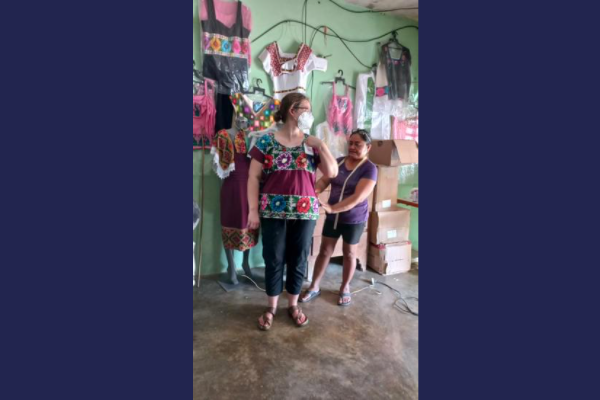Faces of Na’atik: Johanna
Johanna, a doctoral student from Florida focusing on the use of Chicle by the Indigenous Maya people, started learning Maya with us online in March 2021. In August she joined us here in Felipe Carrillo Puerto where she has been continuing her Maya studies and undertaking research for her PhD.
When it came to learning Maya, how did you decide to come to Na’atik for Maya immersion with a homestay family, rather than just doing online classes or pursuing it on your own some other way?
For me, learning Maya was a core part of doing my doctoral field studies. I wanted to both learn the Maya language as well as learn the cultural aspects that come along with it, the experience of getting to know Felipe Carrillo Puerto and just kind of getting my feet on the ground. I figured that language learning was probably as easy of a way to transition myself into a new place and culture as any other way I could think of. It’s probably a little bit different than most people’s needs or approach when it comes to studying at Na’atik, but for me as a researcher, it was kind of a way for me to take those first steps in a supported manner, rather than just showing up somewhere where you don’t know anyone.
Were you exposed to Maya at all before coming to Na’atik?
Not Yucatec Maya (the Mayan language family has several branches of which Yucatec is the most widely spoken). I had talked to people who were Chol-speaking, from the neighboring state of Campeche, during my Masters research. I believe that community had immigrated from Chiapas. Also at one point in Florida, while doing some work with immigrants, I met a woman who spoke a Maya language called Mam (from Guatemala) primarily and we communicated as best as we could, recognizing that Spanish was a second language for both of us.
Johanna visited local Maya craftspeople
So in Campeche, your primary language of communication with community members was in Spanish?
Yes, we were just there briefly within the Chol-speaking community. At one point, they showed us a Bible in Chol and we were looking at it and comparing parts we knew.
Do you have any favorite or memorable parts, whether from the in-class curriculum, your homestay, excursions or using Maya during your research?
I really appreciated having the opportunity to take one-on-one classes with my Maya teacher, Paulino. I had actually started taking classes with him about 6 months before I came to Na’atik. So I already had some of the basic background knowledge, but hearing Maya being spoken by my host family or on the streets of Carrillo went a long way towards helping my comprehension. It was a really cool feeling the first time someone said a short phrase to me and I felt like I knew what they were saying.
Who, as in what kind of personality, learner or traveler, would you recommend come for an immersion course at Na’atik?
I think that Na’atik in general meets the needs of a lot of different people. I’ve met students who were here for survival reasons, so for example expats who are now living in Mexico and want to improve their Spanish to be able to better connect with the community they’re living in, I’ve met people who were here to learn Spanish more casually because they had the means to do so and wanted to try something different. There are people who come to study for professional reasons. For me, like I said, learning Maya was a core part of my academic and professional needs. I can see how it could also be a positive experience for families who come, even with young kids. I think Na’atik is a good place for a variety of people who are interested in learning either Spanish or Maya for a wide variety of reasons.
Johann studied Maya here with her teacher Paulino
Johanna is currently planning on finishing her studies in Mexico in May and we wish Johanna all the best as she continues her academic and Maya language studies. We look forward to staying in touch with Johanna even after she returns to the US.
If you would like to know more about our Maya Immersion program, or are interested in studying online, please contact us at say@naatikmexico.org or click here.



